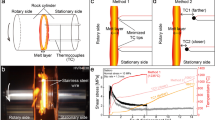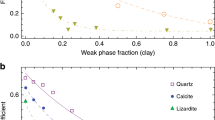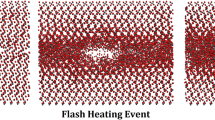Abstract
The friction on fault planes that controls how rocks slide during earthquakes decreases significantly as a result of complex fault-lubrication processes involving frictional melting. Fault friction has been characterized in terms of the preferential melting of minerals with low melting points—so-called disequilibrium melting. Quartz, which has a high melting temperature of about 1,726 °C and is a major component of crustal rocks, is not expected to melt often during seismic slip. Here we use high-velocity friction experiments on quartzite to show that quartz can melt at temperatures of 1,350 to 1,500 °C. This implies that quartz within a fault plane undergoing rapid friction sliding could melt at substantially lower temperatures than expected. We suggest that depression of the melting temperature is caused by the preferential melting of ultra-fine particles and metastable melting of β-quartz at about 1,400 °C during extreme frictional slip. The results for quartzite are applicable to complex rocks because of the observed prevalence of dynamic grain fragmentation, the preferential melting of smaller grains and the kinetic preference of β-quartz formation during frictional sliding. We postulate that frictional melting of quartz on a fault plane at temperatures substantially below the melting temperature could facilitate slip-weakening and lead to large earthquakes.
This is a preview of subscription content, access via your institution
Access options
Access Nature and 54 other Nature Portfolio journals
Get Nature+, our best-value online-access subscription
$29.99 / 30 days
cancel any time
Subscribe to this journal
Receive 12 print issues and online access
$259.00 per year
only $21.58 per issue
Buy this article
- Purchase on Springer Link
- Instant access to full article PDF
Prices may be subject to local taxes which are calculated during checkout




Similar content being viewed by others
References
Goldsby, D. L. & Tullis, T. E. Flash heating leads to low frictional strength of crustal rocks at earthquake slip rates. Science 334, 216–218 (2011).
Di Toro, G., Hirose, T., Nielsen, S., Pennacchioni, G. & Shimamoto, T. Natural and experimental evidence of melt lubrication of faults during earthquakes. Science 311, 647–649 (2006).
Spray, J. G. Evidence for melt lubrication during large earthquakes. Geophys. Res. Lett. 32, L07301 (2005).
Collettini, C., Viti, C., Tesei, T. & Mollo, S. Thermal decomposition along natural carbonate faults during earthquakes. Geology 41, 927–930 (2013).
Han, R., Shimamoto, T., Hirose, T., Ree, J.-H. & Ando, J.-i. Ultralow friction of carbonate faults caused by thermal decomposition. Science 316, 878–881 (2007).
Brantut, N., Schubnel, A., Corvisier, A. J. & Sarout, J. Thermochemical pressurization of faults during coseismic slip. J. Geophys. Res. 115, B05314 (2010).
Violay, M., Di Toro, G., Nielsen, S., Spagnuolo, E. & Burg, J. P. Thermo-mechanical pressurization of experimental faults in cohesive rocks during seismic slip. Earth Planet. Sci. Lett. 429, 1–10 (2015).
Niemeijer, A. et al. Inferring earthquake physics and chemistry using an integrated field and laboratory approach. J. Struct. Geol. 39, 2–36 (2012).
Lin, A. Lecture Notes Earth Sci.Ch. 8 & 12, Vol. 111, 159–176, 283–320 (Springer, 2008).
Tullis, T. E. Treatise on Geophysics Vol. 4, 131–152 (Elsevier, 2007).
Di Toro, G., Pennacchioni, G. & Nielsen, S. Fault-Zone Properties and Earthquake Rupture Dynamics Vol. 94, 87–133 (International Geophysics, 2009).
Spray, J. G. Artificial generation of pseudotachylyte using friction welding apparatus - Simulation of melting on a fault plane. J. Struct. Geol. 9, 49–60 (1987).
Spray, J. G. Pseudotachylyte controversy: fact or friction. Geology 23, 1119–1122 (1995).
Hirose, T. & Shimamoto, T. Growth of molten zone as a mechanism of slip weakening of simulated faults in gabbro during frictional melting. J. Geophys. Res. 110, B05202 (2005).
Lavallee, Y., Hirose, T., Kendrick, J. E., Hess, K.-U. & Dingwell, D. B. Fault rheology beyond frictional melting. Proc. Natl Acad. Sci. USA 112, 9276–9280 (2015).
Bestmann, M., Pennacchioni, G., Frank, G., Göken, M. & De Wall, H. Pseudotachylyte in muscovite-bearing quartzite: coseismic friction-induced melting and plastic deformation of quartz. J. Struct. Geol. 33, 169–186 (2011).
Bestmann, M., Pennacchioni, G., Nielsen, S., Goeken, M. & de Wall, H. Deformation and ultrafine dynamic recrystallization of quartz in pseudotachylyte-bearing brittle faults: a matter of a few seconds. J. Struct. Geol. 38, 21–38 (2012).
Ohtomo, Y. & Shimamoto, T. Significance of thermal fracturing in the generation of fault gouge during rapid fault motion: an experimental verification. J. Tectonic Res. Group Jpn 39, 135–144 (1994).
Rowe, C. D. & Griffith, W. A. Do faults preserve a record of seismic slip: a second opinion. J. Struct. Geol. 78, 1–26 (2015).
Lee, S. K. Simplicity in melt densification in multi-component magmatic reservoirs in Earth’s interior revealed by multi-nuclear magnetic resonance. Proc. Natl Acad. Sci. USA 108, 6847–6852 (2011).
Stebbins, J. F. & Xue, X. Y. in Spectroscopic Methods in Mineralology and Materials Sciences Vol. 78 (eds Henderson, G. S., Neuville, D. R. & Downs, R. T.) 605–653 (Mineralogical Society of America, 2014).
Lee, S. K. & Stebbins, J. F. The degree of aluminum avoidance in aluminosilicate glasses. Am. Mineral. 84, 937–945 (1999).
Hayashi, N. & Tsutsumi, A. Deformation textures and mechanical behavior of a hydrated amorphous silica formed along an experimentally produced fault in chert. Geophys. Res. Lett. 37, L12305 (2010).
Lee, S. K. & Ahn, C. W. Probing of 2 dimensional confinement-induced structural transitions in amorphous oxide thin film. Sci. Rep. 4, 4200 (2014).
Buffat, P. & Borel, J. P. Size effect on melting temperature of gold particles. Phys. Rev. A 13, 2287–2298 (1976).
Hirose, T. & Shimamoto, T. Fractal dimension of molten surfaces as a possible parameter to infer the slip-weakening distance of faults from natural pseudotachylytes. J. Struct. Geol. 25, 1569–1574 (2003).
Goldsby, D. L. & Tullis, T. E. Low frictional strength of quartz rocks at subseismic slip rates. Geophys. Res. Lett. 29, GL015240 (2002).
Kennedy, G. C., Wasserburg, G. J., Heard, H. C. & Newton, R. C. The upper three-phase region in the system SiO2–H2O. Am. J. Sci. 260, 501–521 (1962).
Bourova, E. & Richet, P. Quartz and cristobalite: high-temperature cell parameters and volumes of fusion. Geophys. Res. Lett. 25, 2333–2336 (1998).
Nielsen, S., Di Toro, G., Hirose, T. & Shimamoto, T. Frictional melt and seismic slip. J. Geophys. Res. 113, B01308 (2008).
Niemeijer, A., Di Toro, G., Nielsen, S. & Di Felice, F. Frictional melting of gabbro under extreme experimental conditions of normal stress, acceleration, and sliding velocity. J. Geophys. Res. 116, B07404 (2011).
Han, R., Hirose, T. & Shimamoto, T. Strong velocity weakening and powder lubrication of simulated carbonate faults at seismic slip rates. J. Geophys. Res. 115, B03412 (2010).
Togo, T. & Shimamoto, T. Energy partition for grain crushing in quartz gouge during subseismic to seismic fault motion: an experimental study. J. Struct. Geol. 38, 139–155 (2012).
Ji, C., Helmberger, D. V., Wald, D. J. & Ma, K. F. Slip history and dynamic implications of the 1999 Chi-Chi, Taiwan, earthquake. J. Geophys. Res. 108, B92412 (2003).
Lee, R. J., Ramsey, M. S. & King, P. L. Development of a new laboratory technique for high-temperature thermal emission spectroscopy of silicate melts. J. Geophys. Res. 118, 1968–1983 (2013).
Acknowledgements
This work was supported by the National Research Foundation (NRF), Korea to S.K.L. (2014-053-046), by the Korea Meteorological Administration Research and Development Program to R.H. (KMIPA 2015-7050), by the NRF, Korea to G.Y.J. (2011-0028597) and by JSPS KAKENHI to T.H. (16H04064). We are grateful for helpful comments by Y. Wang. We thank K. Oohashi for his help in one of the experiments and J. O. Jeong for his technical assistance in EPMA and SEM analyses. We are grateful for careful and constructive suggestions by M. Bestmann and M. Violay, which greatly improved the manuscript’s quality and clarity.
Author information
Authors and Affiliations
Contributions
S.K.L. and R.H. developed the project. S.K.L. wrote the manuscript and developed the frictional melting model. R.H. wrote the section describing mechanical data and temperature measurements. R.H. and T.H. performed the rotary-shear experiment and temperature analyses. R.H. performed the SEM-EDS/EPMA analyses. G.Y.J. performed the TEM analyses. S.K.L., E.J.K. and H.K. performed the NMR, Raman and XRD experiments; S.K.L. and E.J.K. analysed the data. All authors discussed the results and commented on the manuscript.
Corresponding author
Ethics declarations
Competing interests
The authors declare no competing financial interests.
Supplementary information
Supplementary Information
Supplementary Information (PDF 1088 kb)
Rights and permissions
About this article
Cite this article
Lee, S., Han, R., Kim, E. et al. Quasi-equilibrium melting of quartzite upon extreme friction. Nature Geosci 10, 436–441 (2017). https://doi.org/10.1038/ngeo2951
Received:
Accepted:
Published:
Issue Date:
DOI: https://doi.org/10.1038/ngeo2951
This article is cited by
-
Frictional melting mechanisms of rocks during earthquake fault slip
Scientific Reports (2023)
-
Study on the Mode I Fracture Properties of Granites After Heating and Water-Cooling Treatments Under Different Impact Loadings
Rock Mechanics and Rock Engineering (2022)
-
Viscous strengthening followed by slip weakening during frictional melting of chert
Earth, Planets and Space (2019)



